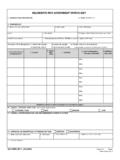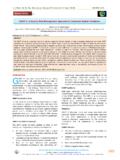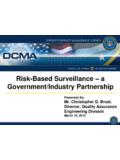Transcription of Drumahoe Primary School
1 Drumahoe Primary School RRiisskk AAsssseessssmmeenntt Risk Assessment Policy INTRODUCTION This policy is designed to assist the School in fulfilling their legal duties in assessing risks . Risk management is the consideration of the risks that arise in the workplace and then putting in place sensible health and safety measures to control them. In accordance with our duties under the Management of Health and Safety at Work Regulations 2000, the School is required to undertake regular risk assessments and take any necessary action arising from these according to provisions set out in the Health and Safety policy and elsewhere.
2 The Principal is responsible for making sure that risk assessments are completed, logged and effectively monitored. Reviews are conducted when there is any change to equipment or resources, any change to the School s premises, or when particular needs of a child or other visitor necessitate this. The Principal is further responsible for conducting any necessary reviews or making changes to the School s policies or procedures in the light of any potential risks that they or other members of staff discover. A visual inspection of both the equipment and the entire premises both indoor and outdoor will be carried out daily.
3 This will, ordinarily, be carried out by a designated member of staff (Caretaker) on arrival at the School and will be completed before any children arrive. During the School day, staff will be vigilant and continuously aware of any potential risks to health and safety arising from: the School s environment, both indoors and outdoors; all surfaces, both indoors and outdoors; all equipment used by children or staff. On discovering a hazard, staff will take all steps necessary to making themselves and any other people potentially affected safe.
4 They will then notify the Principal and ensure that a record is made in the Incident Record Book. The Principal is then responsible for ensuring that any necessary action is taken. As already stated, the Management of Health and Safety at Work Regulations (NI) 2000 require that suitable and sufficient assessments of the risk arising out of work are carried out. Put simply, a risk assessment is finding out what could cause harm to people and deciding if you have done enough or need to do more to protect them. The Process of Risk Assessment What can be risk assessed?
5 A risk assessment can be undertaken on an object or substance, a process, a location, an activity, or a person. It is a five step process: Step 1: Identify the hazards Step 2: Decide who might be harmed and how Step 3: Evaluate the risks and decide on precautions Step 4: Record your findings and implement them Step 5: Review your assessment and update if necessary What is a hazard? A hazard is anything which can cause harm electricity, chemicals, etc What is risk? Risk is the chance, high or low, that somebody could be harmed by these and other hazards, together with an indication of how serious the harm could be.
6 Evaluating the risk Having spotted the hazards, you then have to decide what to do about them. The law requires you to do everything reasonably practicable to protect people from harm. You can work this out for yourself, but the easiest way is to compare what you are doing with good practice. There are many sources of good practice, for example HSENI s website ( ) CLEAPSS, etc. So first, look at what you re already doing think about what controls you have in place and how the work is organised. Then compare this with the good practice and see if there s more you should be doing to bring yourself up to standard.
7 In asking yourself this, consider: Can I get rid of the hazard altogether? If not, how can I control the risks so that harm is unlikely? When controlling risks , apply the principles below, if possible in the following order: try a less risky option ( switch to using a less hazardous chemical); prevent access to the hazard ( by guarding); organise work to reduce exposure to the hazard ( put barriers between pedestrians and traffic); issue personal protective equipment ( clothing, footwear, goggles etc); and provide welfare facilities ( first aid and washing facilities for removal of contamination).
8 Involve staff, so that you can be sure that what you propose to do will work in practice. WHAT IS A RISK ASSESSMENT? The Health and Safety Executive (HSE) defines a risk assessment as a careful examination of what in your work could cause harm to people so that you can weigh up whether or not you have taken enough precautions or should do more to prevent harm . The assessment will help you to identify the likelihood of harm and whether you can reduce the risk to a reasonable level, through the introduction of control measures. The five step process is as follows: Step 1: Identify the hazards Divide your work into manageable categories considering: Location Activities Equipment People Identify the Hazards: Chemical paint solvents/exhaust fumes Biological bacteria Physical noise/vibration Psychological occupational stress Step 2: Decide who might be harmed and how For each hazard you need to be clear about who might be harmed, identify the groups of people such as staff members or members of the public/pupils.
9 Identify how they might be harmed what type of injury injury or ill health might occur. Step 3: Evaluate the risks and decide on precautions Consider how likely it is that each hazard will occur and what control measures you already have in place. Have the control measures in place got rid of the hazard altogether or reduced the risk so that harm is unlikely, if the task has not been adequately controlled what further actions are required. If any further actions are required the name of the person responsible for actioning the task should be recorded along with the projected completion date with the actual completion recorded in the completed column.
10 Step 4: Record your findings and implement them Putting the results of your risk assessment into practice will make a difference when looking after our staff. Writing down the results of your risk assessment, and sharing them with the staff, encourages you to do this. Step 5: Review your assessment and update if necessary Risk assessments need to be reviewed and if necessary updated every year. However a review will be required sooner if an incident or accident occurs, or there are significant changes to the premises, staff or procedures.





